
Soft Grain Paper Textures: Elevating Portrait Photography with Subtlety and Depth
Texture has a strange way of guiding the viewer’s gaze. In portrait work, soft grain paper textures provide a tactile layer that your eyes can feel as much as see. They mimic the tactile warmth of traditional film papers, lending mood, depth, and a sense of history to modern digital images. Rather than insisting on drama, these textures invite quiet, intimate storytelling—nudging a candid moment into a timeless one.
“Texture is not noise; it’s a quiet collaborator that steers emotion without stealing focus.”
When used thoughtfully, soft grain textures soften sharp edges, smooth out harsh highlights, and unify color when printing or presenting work online. The goal isn’t to overstate the grain, but to let it breathe—much like a held breath before a smile. In practical terms, texture acts like a bridge between the crisp clarity of a modern sensor and the organic imperfections that give portraits character. It’s particularly effective for skin tones and fabric details, where a gentle film-like grain can add life without becoming distracting.
Texture as a Character: Mood, Depth, and Narrative
Texture carries mood. A finer grain often reads as elegant and timeless, while a coarser option can convey documentary grit or nostalgia. In portraits, the choice of grain should align with the narrative you want to tell. For studio lighting with controlled shadows, a subtle texture can mimic the soft texture of traditional paper under warm studio lights. For environmental or candid work, slightly stronger grain can echo the spontaneity of a moment, making the subject feel more present within a tactile frame.
Color grading also interacts with texture. Grain tends to emphasize tonal relationships and can slightly desaturate midtones, which can be desirable for certain looks. By pairing a soft grain with a restrained color palette, you create an image that feels cohesive across different viewing contexts—print, web, and social media alike.
Practical Workflow: From Capture to Post
- Capture or choose a texture: Start with a collection of soft grain textures that suit your subject’s skin, wardrobe, and lighting. Aim for textures that resemble archival paper—less is more at first.
- Apply subtly: In your editing software, blend the texture using a light overlay or soft light blend mode at low opacity. The texture should sit behind the subject, not overwhelm facial features.
- Control scale and density: Adjust the texture scale to match the image’s dimensions. A portrait shot benefits from a texture that’s visible but not overpowering—think whisper rather than shout.
- Pair with tonality: Fine-tune contrast and color grade to harmonize the texture with your subject’s skin tones. A warm grade often complements soft grain beautifully, while cooler tones can create a modern, cinematic edge.
- Print considerations: If you plan to print, test a proof on soft paper stock to ensure the grain reads as intended in physical form. Print on textured papers to reinforce the tactile feel you’re aiming for.
For photographers exploring these textures in a broader workstation setup, a comfortable editing environment can make a real difference. A well-supported desk setup can help you stay precise during color and grain adjustments. If you’re curious about practical desk upgrades, you might notice this product page Neon Foot-Shaped Mouse Pad with Ergonomic Memory Foam Wrist Rest offering a playful yet ergonomic touch to long editing sessions.
To see a concise real-world application, a recent implementation available on the case study page showcases how soft grain textures can adapt to different lighting and subject matter while preserving natural skin tones. The example demonstrates a balanced approach: texture that supports storytelling without competing with the subject’s expression.
In Practice: Quick Tips for Consistent Results
- Use a single grain texture family across a project to maintain tonal consistency.
- Reserve stronger texture for environmental portraits where background texture would otherwise feel flat.
- Experiment with grain direction by slightly skewing or offsetting the texture layer for a more organic look.